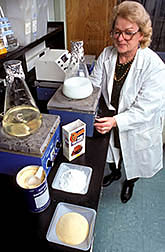Tissue-Culturing Plants on Cornstarch
An ARS horticulturist has formulated a new gelling mixture, made primarily from cornstarch, that can be used successfully for tissue-culture of apples, pears, and raspberries.
At only a fraction of the cost, this product supports plant growth as healthy as, or healthier than, the material now being used.
Tissue-culture allows quick mass-production of plants for such major research areas as disease- and pest-resistance, cold hardiness, and drought tolerance. For example, plantlets for a small apple orchard of about 40 trees can be tissue-cultured in a pint jar.
Tissue-culture medium for reducing clonal plant material now solidified mostly with agar, an expensive standard "gelling agent used by research laboratories throughout the world.
But agar, a seaweed derivative, is not suitable for culturing all plants. "Actually it was this realization, along with the cost of agar, that started my search for an alternative," says Ingrid M. Fordham, a horticulturist with the ARS Fruit Laboratory in Beltsville, Maryland.
"I was using tissue-culture to propagate a research plant, but the shoots kept dying. After about a year of trying various media compositions, I suspected that agar itself might be harmful to this particular plant," she says.
After some experimenting, Fordham hit on a combination of simple cornstarch and Gelrite, a commercially available gellan gum that is also used as a gelling agent.
"I use only a half gram of Gelrite to 50 grams of cornstarch," she says. "I've used this mixture for about 4 years, and in all cases, it has worked as well as, or better than, agar."
She has used the new mixture to tissue-culture six varieties of apples, two varieties of raspberries, and two of pears.
"We got more shoot proliferation with the cornstarch than with agar, which was really a surprise," Fordham says. "And more shoots mean more plants."
Raymond Chee, of the Sigma Chemical Company in St. Louis, Missouri, says that about 100 companies in the United States use agar for plant tissue-culture.
This does not include the many private biotechnology institutes, universities, or federal laboratories that use tissue-culture to reproduce plants. Sigma is the No. 1 supplier of agar in the United States.
"Agar is made from a certain type of alga that grows primarily off the coasts of Spain and Mexico, with Spain being the world's largest supplier," he says. The extraction and refining process probably explains why the material is so expensive.
Fordham says the fruit lab pays about 98 dollars per pound for agar, compared to around 89 cents for a pound of cornstarch; less if purchased in bulk. While it takes 50 grams of starch versus 6 to 8 grams of agar per liter of medium, the cost saving is still considerable.
In addition to Sigma, another major company is interested in the technology.
Easy to produce, the new mixture could help plant research where the expense of agar may be prohibitive.
The research results have been submitted for publication in the Plant Cell Tissue and Organ Culture journal. -- By Doris Stanley, ARS.
Ingrid M. Fordham is at the USDA-ARS Fruit Laboratory, 10300 Baltimore Ave., Beltsville, MD 20705-2350; phone (301) 504-7649, fax (301) 504-5062.
"Tissue-Culturing Plants on Cornstarch" was published in the July 1995 issue of Agricultural Research magazine.







